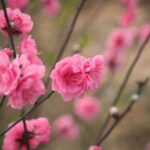Designing a flower garden layout is an important aspect of creating a beautiful and cohesive outdoor space. The right design can enhance the overall aesthetic of your garden, as well as optimize the growth and health of your flowers. Understanding how to assess space, choose the right flowers, create focal points, and incorporate hardscaping are all crucial elements to consider when designing a flower garden layout.
Assessing the space of your garden is the first step in creating a well-designed flower garden layout. Understanding the size and shape of your space will help you determine where to place different types of flowers, as well as where to incorporate pathways or other non-plant elements for structure.
Choosing the right flowers for your garden involves considering climate, soil, and sunlight conditions. Selecting flowers that are well-suited to your specific environment will ensure their optimal growth and longevity. Additionally, incorporating design elements such as focal points can draw attention to specific areas within your garden, adding visual interest and depth. By carefully planning and implementing these design techniques, you can create a visually appealing flower garden layout that showcases the natural beauty of your chosen blooms.
Assessing the Space
When it comes to designing a beautiful flower garden, understanding the size and shape of your garden is essential. Before you start choosing flowers and planning your layout, it’s important to take stock of the space you have available. Assessing the space will help you make the most of your garden, ensuring that your design complements the natural features of the area.
One key consideration when assessing your garden space is the size and shape of the area. Measure the dimensions of your garden and take note of any irregularities in shape. This will help you determine how much planting space you have available and where certain design elements can be incorporated.
In addition to physical measurements, take note of any unique characteristics or features in your garden such as slopes, shaded areas, or existing structures like trees or buildings. Understanding these factors will help you choose the right flowers and plan for any necessary adjustments to create an optimal flower garden layout.
| Assessing Space Factors | Considerations |
|---|---|
| Size and Shape | Measure dimensions and note irregularities |
| Unique Characteristics | Slopes, shade, existing structures |
Choosing the Right Flowers
When it comes to designing a flower garden layout, choosing the right flowers is crucial to ensure a successful and vibrant garden. Selecting flowers based on the climate, soil, and sunlight conditions of your specific garden space will ultimately determine the health and growth of your plants. Here are some tips for selecting the right flowers:
- Research the climate: Before choosing any flowers for your garden, it is important to research the climate of your region. Some flowers thrive in cool climates, while others prefer warmer temperatures. Understanding the typical weather patterns in your area will help you select flowers that are more likely to flourish.
- Evaluate soil conditions: Soil type and quality play a significant role in plant growth. Conduct a soil test to determine the pH levels and nutrient content of your soil. This will help you select flowers that are well-suited to the specific soil conditions in your garden.
- Assess sunlight exposure: Different types of flowers have varying sunlight requirements. Some plants thrive in full sun, while others prefer partial or full shade. Assess the sunlight exposure in different areas of your garden to determine which types of flowers will thrive in each location.
Once you have gathered information about the climate, soil, and sunlight conditions in your garden, you can begin selecting flowers that are best suited for optimal growth. By carefully considering these factors, you can create a flower garden layout that is not only visually stunning but also promotes healthy plant growth in your specific environment.
In addition to considering these essential factors when choosing flowers for your garden, it’s also beneficial to consult with local nurseries or gardening experts who can provide tailored advice based on the unique characteristics of your gardening space. With careful planning and consideration, you can create a beautiful and thriving flower garden that enhances the visual appeal of your outdoor space.
Creating Focal Points
One of the key aspects of a well-designed flower garden layout is the use of focal points to draw attention to specific areas within the garden. One way to create focal points is by using color and contrast.
By grouping flowers of different colors together, you can create eye-catching displays that naturally draw the eyes of onlookers. Additionally, planting flowers with contrasting colors next to each other can provide a visually stunning effect that serves as a focal point in the garden.
Another important consideration when creating focal points is to vary the heights of your plants. Taller plants can naturally draw the eyes upwards, creating visual interest and providing a natural focal point within the garden. Using taller flowers or ornamental grasses strategically placed throughout the garden can help create an aesthetically pleasing landscape with various focal points.
Incorporating Hardscaping for Visual Interest
In addition to utilizing plants as focal points, hardscaping elements can also be used to draw attention to specific areas in the garden. Adding features such as trellises, sculptures, or water features can instantly create visual interest and serve as focal points within the overall design. These non-plant elements add structure and dimension to the garden while providing unique focal points that complement the surrounding floral displays.
Strategic Lighting for Nighttime Appeal
Finally, when designing a flower garden layout, it’s important to consider how it will look at night. Implementing strategic lighting elements can further enhance your focal points and overall design. By adding spotlights or pathway lights near your selected focal points, you can ensure that they remain visually appealing even after dark. This adds another layer of depth and intrigue to your flower garden layout, creating a captivating atmosphere for both daytime and nighttime enjoyment.
Planting Techniques
Spacing Considerations
When it comes to planting your flower garden, proper spacing is crucial for the health and growth of your plants. Overcrowding can lead to competition for nutrients and sunlight, while too much space between plants can leave gaps in your garden. It is important to research the specific spacing requirements for each type of flower you plan to include in order to ensure they have enough room to thrive.
Depth and Arrangement
Understanding the proper depth for planting each type of flower is essential for their success. Some flowers require deeper planting to establish strong root systems, while others may need more shallow soil. Additionally, consider the arrangement of your flowers – taller plants should be placed toward the back of the garden to prevent shading smaller ones, while cascading or low-growing flowers can be used as border plants or along pathways to add visual interest.
Companion Planting
Consider companion planting techniques when designing your flower garden layout. Certain flowers complement each other well and may even provide benefits such as pest control or improved pollination. Research which flowers work best when planted together and take advantage of these symbiotic relationships to create a thriving and diverse garden space.
By carefully considering spacing, depth, arrangement, and companion planting techniques, you can optimize the growth and beauty of your flower garden. Taking these factors into account will not only help your garden flourish but also contribute to creating a visually appealing and harmonious outdoor space that you can enjoy year-round.
Incorporating Hardscaping
The use of hardscaping in a flower garden layout can add structural elements that complement the natural beauty of the flowers. Pathways, borders, and other non-plant elements help create a sense of organization and cohesion within the garden. When incorporating hardscaping, it is important to consider the overall design of the space and how these elements will enhance the visual appeal and functionality of the garden.
Pathways are an essential aspect of hardscaping as they provide both aesthetic value and practicality. A well-designed pathway can guide visitors through the garden while also offering a place for contemplation and enjoyment of the surrounding beauty. It is important to choose materials that work well with the overall theme of the garden, whether it be rustic stone, elegant brick, or natural gravel.
Borders are another key element in hardscaping that can define specific areas within the flower garden layout. Borders can be used to separate different types of flowers or create a distinction between the garden and other parts of your outdoor space.
Additionally, borders can serve as planting beds for additional flowers or even act as a barrier to protect delicate areas from foot traffic or pets. By carefully selecting materials and shapes for borders, you can further enhance the aesthetic appeal of your flower garden layout while providing structure and organization to your design.
Maintenance and Care
Maintaining a healthy and vibrant flower garden is essential to enjoying its beauty year-round. Proper care and maintenance will ensure that your garden continues to thrive, bringing joy and color to your outdoor space. Here are some important steps to take in order to keep your flower garden looking its best throughout the seasons:
- Regular watering: Depending on your climate and the type of flowers you have, it’s important to establish a regular watering schedule. Some flowers may require daily watering, while others can thrive with less frequent watering.
- Weeding: Keeping your flower garden free of weeds is crucial for the health of your plants. Regularly inspecting and removing any unwanted growth will prevent competition for nutrients and sunlight.
- Fertilizing: Providing the necessary nutrients for your flowers is vital for maintaining their health. Consider using a slow-release fertilizer or organic options to avoid overfeeding or burning the plants.
In addition to these basic maintenance tasks, it’s important to stay vigilant for any signs of pests or diseases that could affect your flowers. Whether it’s aphids, snails, or fungal infections, early detection and proper treatment are key in keeping your garden healthy.
Taking the time to properly care for your flower garden will ensure that it remains a beautiful oasis throughout the changing seasons. By following these maintenance steps, you can enjoy vibrant blooms and lush greenery in your garden year after year.
Showcasing Your Design
When it comes to showcasing your flower garden design, using different styles and themes can add a unique and visually appealing touch to your outdoor space. One popular approach is the use of color schemes, where you can choose flowers that complement each other in terms of color, creating an eye-catching and cohesive look. For example, a monochromatic color scheme using varying shades of purple can create a sense of harmony and elegance in your garden.
Another way to showcase your flower garden design is by incorporating themes. This could include creating a specific style such as English cottage gardens or Japanese Zen gardens. By adopting a theme, you can bring a sense of unity and purpose to your garden layout, making it more than just an assortment of plants but rather an intentional and thought-out design.
Lastly, consider using different planting techniques to showcase your design. Experiment with raised beds, vertical gardening, or even creating floral arrangements in unique containers such as wooden barrels or hanging baskets. These techniques not only add visual interest but also allow you to make the most of limited space while adding dimension to your garden layout.
By utilizing these different styles and themes in showcasing your flower garden design, you can elevate the visual appeal of your outdoor space while expressing your personal taste and creativity.
| Flower Garden Design Tips | Examples |
|---|---|
| Color Schemes | Monochromatic purples for harmony and elegance |
| Themes | English cottage gardens or Japanese Zen gardens |
| Planting Techniques | Raised beds, vertical gardening, unique containers |
Conclusion
In conclusion, creating a well-designed flower garden layout is essential for a beautiful and thriving outdoor space. By carefully assessing the size and shape of your garden, choosing the right flowers based on environmental conditions, creating focal points, using proper planting techniques, and incorporating hardscaping elements, you can achieve a stunning and harmonious design. Additionally, consistent maintenance and care along with showcasing your design through various styles and themes will further enhance the overall appeal of your flower garden.
It is important to remember that a well-planned flower garden layout not only adds aesthetic value to your home but also provides a peaceful and tranquil environment for relaxation and enjoyment. By investing time in thoughtful planning and creative design, you can create a space that brings joy throughout the seasons. Whether you have a large backyard or a small patio area, there are endless possibilities to get creative with your own designs.
Ultimately, designing a flower garden layout is an opportunity to express your personal style and creativity while bringing natural beauty into your outdoor space. So take advantage of the resources available to learn about different flowers, hardscaping elements, and maintenance techniques. With dedication and enthusiasm, you can create a stunning flower garden that will be admired by all who visit.
Frequently Asked Questions
How Do You Plan a Flower Garden Layout?
When planning a flower garden layout, it’s important to consider the sunlight and soil conditions in the chosen area. Start by sketching out the space and deciding which types of flowers and plants you’d like to include.
Think about the height, color, and blooming times of each variety to ensure a balanced and visually appealing arrangement. Consider using focal points or centerpieces, such as a large flowering bush or ornamental tree, to anchor the design.
Is There an App to Plan a Flower Garden?
Yes, there are several apps available to help plan a flower garden. Some apps offer features like virtual garden plotting, plant libraries with detailed information, and even personalized recommendations based on your location and climate. These apps can be a helpful tool for both novice and experienced gardeners who want to visualize their garden layout before planting.
How Do I Arrange Flowers and Plants in My Garden?
When arranging flowers and plants in your garden, consider factors such as plant size, shape, texture, and color. Grouping plants with similar water and sunlight needs together can make maintenance easier. Pay attention to the blooming seasons of different flowers to ensure continuous color throughout the year.
Utilize taller plants at the back of borders or in the center of island beds, with shorter varieties towards the front for depth and visual interest. By carefully arranging your flowers and plants, you can create an aesthetically pleasing garden that enhances your outdoor space.

Welcome to my gardening blog! I am passionate about plants and enjoy sharing my knowledge and experiences with others. In this blog, I will write about everything related to gardening, from tips on how to get started to updates on my own garden projects.





